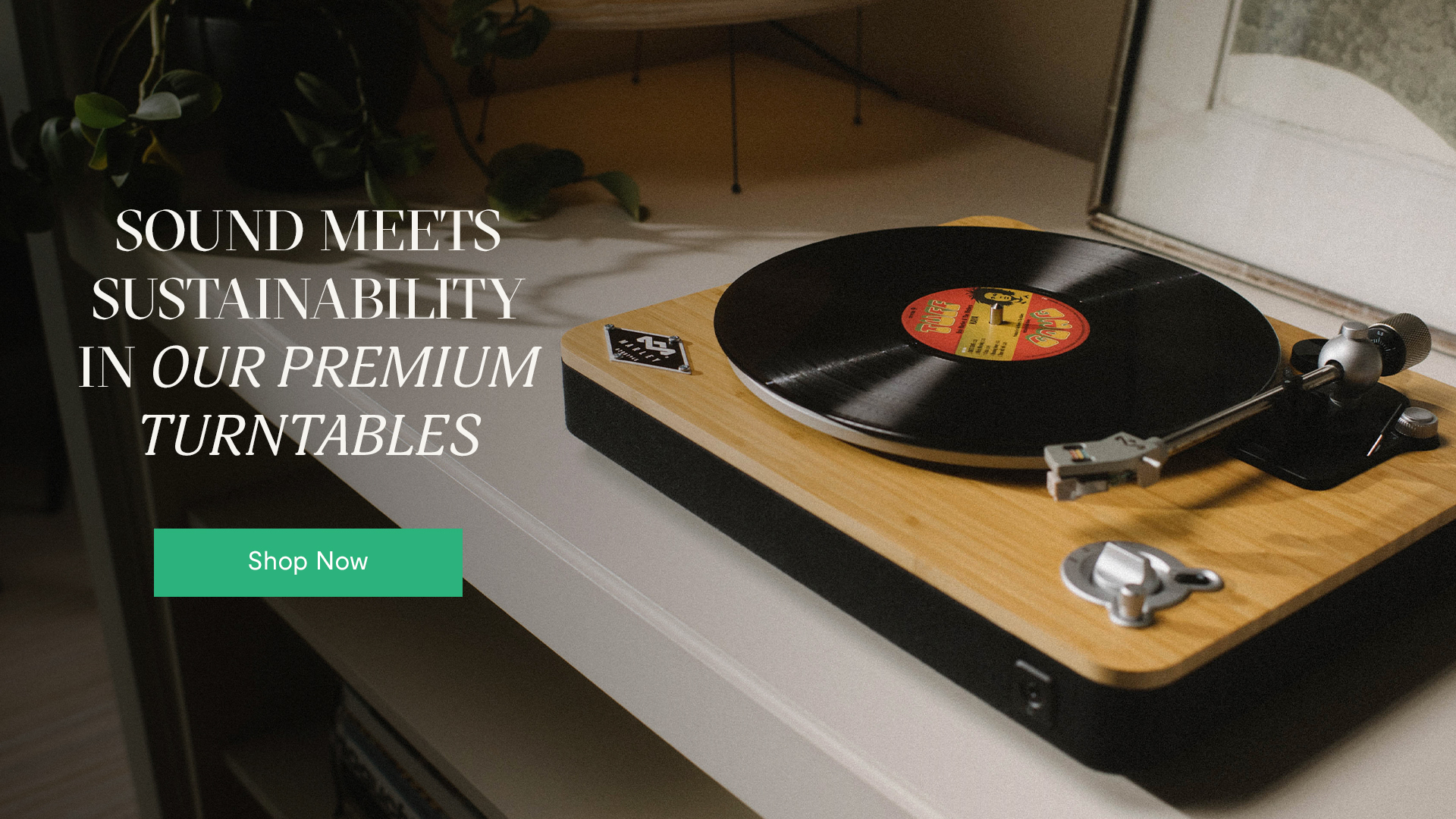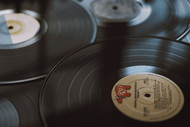How are Vinyl Records Made?
Posted by House of Marley on Jul 28th 2022
The needle drops on the record. A gentle hiss—and maybe a pop or two—emanates from your speakers. After a few moments, music fills the room, richer and warmer than ever. Music lovers have enjoyed this ritual for decades, but not everyone can answer the question, “How are vinyl records made?”
In 1877, Thomas Edison changed the fate of the music industry when he invented the phonograph, the first device that could capture recorded music. He even called it his favorite invention. “I like the phonograph best … because I love music,” Edison told B.C. Forbes in 1921. Edison’s invention led to the creation of the gramophone and in 1931, RCA Victor launched the vinyl record as we know it today.
Fast forward to the 21st century—41.7 million vinyl records were sold in 2021 alone. Despite the technology being almost 100 years old, record pressing plants are still using the same traditional process—and often the exact same machines—to make vinyl records as they did in the 1960s. To understand more about this enduring technology, check out our article, 'How Do Vinyl Records Work?', which explores the fascinating mechanics behind vinyl playback.

What starts in the recording studio ends up on your turntable. From cutting a record to pressing vinyl and beyond, we’ll walk you through how a vinyl record is made.
Step 1: Recording Music
The vinyl process starts in a music studio, where your favorite musicians record their albums and singles. Modern recording is the process of capturing analog sound—the raw sound waves of the music—and converting them into digital audio files. Typically, studios today focus on digital recording, but sometimes bands still prefer to record directly to analog tape.
Although it’s a rarity these days—and has been since the 1950s—some studios specialize in fully analog direct-to-acetate recording, allowing artists to record straight to a vinyl-cutting lathe. That’s where the phrase “cutting a record” was born.
Step 2: Mixing and Mastering for Vinyl
After the artists finish recording, the audio tracks are sent to sound engineers for mixing and mastering.
Mixing involves adjusting the raw recording to make sure it brings the band’s vision to life. To get a balanced mix, sound engineers fine-tune each audio instrument and vocal take. When the artists are satisfied with the sound, the mixes are delivered to a mastering engineer who applies the finishing touches.
This is where the process changes for vinyl vs. digital recordings and CDs. Mastering engineers use a set of tools to optimize the sound of each mix, including equalization (EQ), compression, limiting and saturation. When a band wants to release a record on vinyl, the mastering engineer uses special audio-editing techniques to ensure the master recordings sound perfect on vinyl records—which offer a different dynamic range than digital formats. If bands don’t get a specific vinyl master alongside a digital master, the resulting vinyl is likely to be distorted.
Step 3: Cutting the Master Disc
Before vinyl records are manufactured, the master recordings are cut using a cutting lathe—a special machine that carves pre-recorded music into blank master discs.
Similar to vinyl records, master discs have grooves that contain recorded sound. However, master discs are made from lacquer-coated aluminum or copper. When you use copper, we call this Direct Metal Mastering (DMM)—a similar process that produces sharper sound and more accurate vinyl pressings.
The engineers wear anti-static clothing and silk gloves during the cutting process to prevent particles and fingerprints from tarnishing the master disc. Even the smallest speck of dust can ruin the sound of an entire batch of vinyl records.
When the engineer begins cutting, a special stylus (or needle) cuts the master recording into the surface of the disc. The cutting engineers keep a close eye on the stylus and monitor the sound levels to make sure the groove is cut correctly. Otherwise, the vinyl records will have imperfections like distortion or excessive pops.
After the grooves are cut, the master disc is inspected for flaws, serialized and signed by the engineer before moving on to the next step.
Step 4: Making the Stamper
The next step in the vinyl process is to create stampers. These stampers are used to press the groove of the master recording into blank vinyl discs—the iconic medium you know and love.
First, the master discs are coated with liquid silver, dipped into large vats of pure nickel and given an electromagnetic charge. This step, known as electroplating, is specifically for making stampers from nitro-lacquered master discs. Copper discs that are cut via Direct Metal Mastering don’t need to be electroplated to produce record stampers.
After the discs are plated, they’re given an electrified water bath filled with dissolved nickel. The nickel fills in the grooves of the silver side of the master disc. When the discs are removed from the bath, engineers separate the metal layer—a mirror image of the original master disc.
The separated layer is the stamper for pressing new vinyl records. Typically, stampers can produce around 1500 records, so higher-volume vinyl pressings may need multiple stampers to get through a full production run.
Finally, the engineer trims away any excess metal and makes a hole in the center of the stamper. After the stamper is ready, the record stickers (also known as labels, not to be confused with the record label that distributes the album) are prepared for a fresh batch of vinyl records.
Step 5: Pressing the Vinyl Records
With the stamper created and the printed labels ready to go, the vinyl is finally ready to press.
First, “vinyl biscuits” are made from polyvinyl chloride (PVC). Black is the most common color for vinyl records, but the options for colors are essentially limitless. With the record labels in place, the stampers press the vinyl biscuits under tremendous heat and pressure.
Together, the heat and pressure mold the vinyl into shape, pressing the master recording—or groove—into the surface of the vinyl.
After the records are pressed into shape, engineers trim the edges and allow them to cool. Packaging the records without letting them cool can cause them to warp—but if you do come across a warped record, there are a handful of ways to fix it.
Step 6: Test Pressings and Final Inspection
Unlike producing CDs or releasing an album digitally, vinyl records have a lot of room for error. That’s why it’s essential each run is thoroughly inspected before being sent to distribution. In addition to internal checks at the record pressing plant, 5-10 test pressings are sent to the artist, record label and other relevant stakeholders.
Those who are sent these pressings listen to each copy of the test pressing and follow a checklist—usually provided by the pressing plant—to ensure that the records are ready for a full production run. That checklist includes:
- Listening for consistent pops: It’s not uncommon for any copy of a record to have some pops, especially the earliest pressings on a particular stamper. However, it’s cause for concern if each copy of the test pressing has a pop in the exact same place. This is a sign that the stamper or master disc has an imperfection.
- Extreme distortion: The first 30 or so pressings made from any stamper are more likely to have a little extra distortion, which is why they’re usually recycled instead of sold. If there’s a lot of distortion, however, it’s a sign that the music wasn’t mastered well for vinyl.
- Other information: Are the songs in the right order? Are all the tracks actually on the album? Does the information on the sticker and album art match in terms of the tracklist? Is the catalog number (often printed directly into the vinyl) correct? This is your last chance to correct those mistakes.
After the test pressing is approved, the vinyl plant begins mass-producing the entire run. It can take anywhere from a few weeks to several months for the records to be ready for distribution—it all depends on the capacity and workload of the pressing plant.
After the production run is complete, the records are delivered to the distributor, which is usually the record label or the artist. The only thing left to do is send them to a record store near you!
Enjoy the Warm Sound of Vinyl
For over 70 years, the record industry has used this same method to make vinyl records—and they still deliver the same high-quality sound using a tried-and-true process. To experience classic vinyl warmth, build your hi-fi set up with the House of Marley Stir It Up Turntable and our premium speakers.













